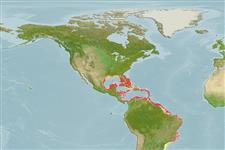Classification / Names
Common names from other countries
Main reference
Size / Weight / Age
Max length : 33.6 cm TL male/unsexed; (Ref. 5217); common length : 25.0 cm TL male/unsexed; (Ref. 5217); max. published weight: 588.00 g (Ref. 5217)
Environment
Marine; demersal; depth range 1 - 100 m (Ref. 9626)
Climate / Range
Subtropical, preferred 26°C (Ref. 107945); 30°N - 33°S, 99°W - 30°W
Distribution
Western Atlantic: Texas and eastern Florida (USA) and Jamaica to Brazil. Including western Gulf of Mexico, Puerto Rico, Lesser Antilles, Central and South American coasts (Ref. 26938). Also found in Argentina (Ref. 86320).
Countries | FAO areas | Ecosystems | Occurrences | Introductions
Short description
IUCN Red List Status (Ref. 115185)
Threat to humans
Harmless
Human uses
Fisheries: commercial; aquarium: public aquariums
More information
ReferencesAquacultureAquaculture profileStrainsGeneticsAllele frequenciesHeritabilityDiseasesProcessingMass conversion
Tools
Special reports
Download XML
Internet sources
Estimates of some properties based on models
Phylogenetic diversity index
PD50 = 0.6250 many relatives (e.g. carps) 0.5 - 2.0 few relatives (e.g. lungfishes)
Trophic Level
3.6 ±0.3 se; Based on diet studies.
Resilience
Medium, minimum population doubling time 1.4 - 4.4 years (Assuming tm=2)
Vulnerability
Low to moderate vulnerability (27 of 100)
Price category
